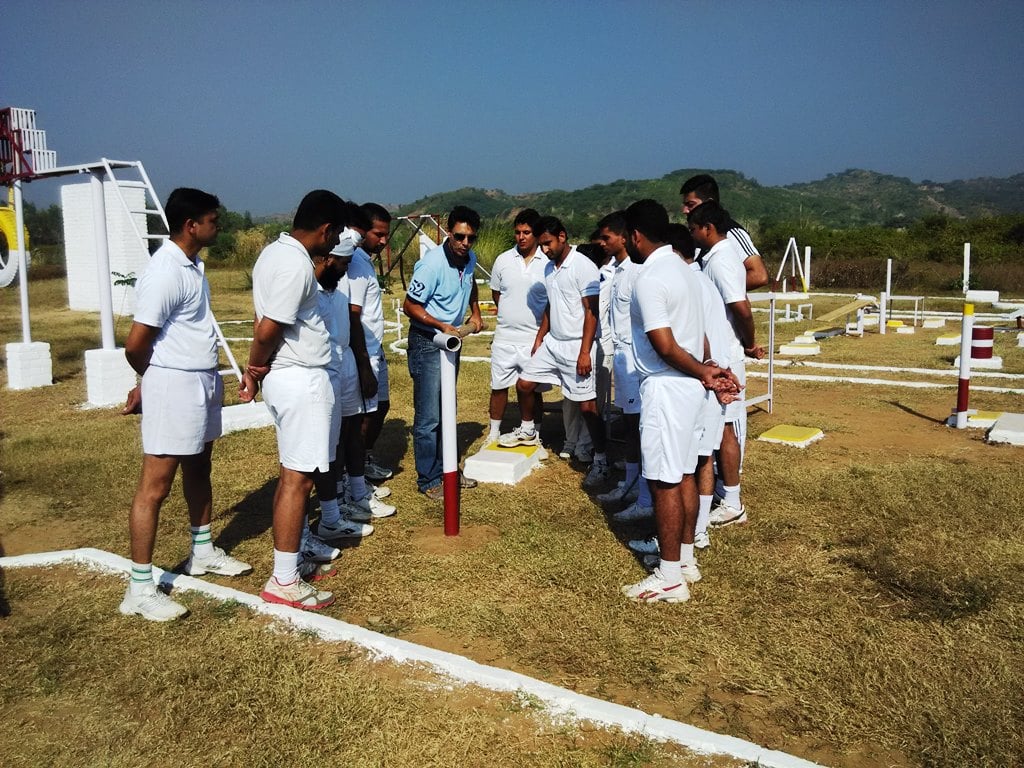The Progressive Group Task (PGT) is the first outdoor field exercise in the GTO (Group Testing Officer) series during the SSB Interview. It plays a pivotal role in forming your initial impression on the GTO, which can influence how you are assessed in subsequent tasks.
Since first impressions matter, performing well in PGT can set a positive tone for the rest of the GTO activities.
1. What Is PGT?
In the PGT, you and your group must cross a designated piece of land using structures painted in different colors, each with its own set of restrictions. You are also given a few helping materials—usually a rope, a wooden plank, and a wooden log—and a load that you must carry across the obstacles. The objective is to reach from the start line to the finish line together, strictly following certain rules (Group Rule, Color Rule, Rule of Infinity, Rule of Rigidity, Jump Rule, etc.).
Why Is It Important?
- Checks Practical Working Sense: The task simulates real-life military situations where one must use minimal resources (like building makeshift bridges during floods or emergencies).
- Assesses Leadership and Teamwork: You must show initiative, guide your team, and ensure everyone (including the load) crosses safely.
- Evaluates Risk-Taking and Enthusiasm: Military personnel often face risky conditions, so this exercise reveals your willingness to step forward, test solutions, and motivate others.
- Tests Quick Thinking: How rapidly you generate feasible ideas under constraints reveals your practical intelligence and problem-solving ability.
2. Rules to Remember
- Group Rule: The entire team must move ahead together. No one (including the load) can be left behind at any stage.
- Color Rule: Structures are painted in multiple colors, each indicating whether it can be touched by you, the helping material, or both. (Exact colors and their meanings can vary, but typically:
- White: Both candidate and helping materials are allowed.
- Black/Yellow: Only candidates can step; no materials allowed.
- Red: Out of bounds for both candidate and materials.)
- Rule of Infinity: You cannot bypass obstacles by going around them. The start and end lines extend infinitely, so crossing must be done through the structure.
- Rule of Rigidity: You cannot tie two rigid objects together (e.g., the plank and the log), but you can tie them to the obstacle or use the rope appropriately.
- Jump Rule: You cannot jump a distance more than a certain limit (commonly four feet). If the gap is larger, you must bridge it using the helping materials.
3. Tips and Strategies for PGT Success
- Use Simple Physics
- Employ basic lever and cantilever principles to create stable bridges.
- Aim for solutions that remain intact without constant human support.
- Lead by Example
- If you propose an idea, offer to demonstrate or implement it.
- Step onto the makeshift bridge first to show confidence and reduce hesitation in the group.
- Be Willing to Take Risks
- Don’t fear failure; even if the bridge collapses, try again with a new approach.
- Maintain a positive attitude—SSB values initiative.
- Remember the Load and Materials
- Always keep track of the load and any rope/plank/log you used.
- Do not leave them behind.
- Respect and Support Your Group Members
- Avoid shouting or criticizing; encourage everyone politely.
- If someone is hesitant, guide them calmly or offer help only if genuinely needed.
- Adhere to Rules and Accept Mistakes
- If you accidentally break a rule (touch a red area, jump too far, etc.), acknowledge and correct it.
- Integrity is a highly regarded quality in an officer.
- Be Energetic and Motivating
- Keep the momentum going; a slow or indecisive approach can hinder the entire group.
- Ensure nobody feels left out or discouraged.
- Stay Alert to GTO Instructions
- When the GTO speaks, stop and listen attentively.
- Avoid looking at the GTO for approval during the task; focus on the group and the challenge.
4. What the GTO Observes
- Team Spirit: Are you actively cooperating, or just imposing ideas without listening?
- Leadership Skills: Do you show initiative in solving problems and guiding your peers?
- Communication: Clear and concise instructions foster efficient teamwork.
- Practical Thinking: Quick, logical solutions that adhere to the rules.
- Risk Management: Balancing bold moves with safety and group cohesion.
5. Final Thoughts
The Progressive Group Task is not just about crossing obstacles; it’s about showcasing your potential as a team player and a future leader. By blending creativity, confidence, empathy, and discipline, you will leave a strong impression on the GTO.
Remember, a genuine display of officer-like qualities in PGT can set the stage for success in the tasks that follow.





